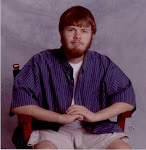I am a scientist at my core – I have a need for logic, reasoning and deduction. It is clear to me now that Matt suffered absence seizures and this led to a dysfunction in his ability to integrate his senses. A few misguided synapses and the result is autism. Seizures in autistic children are not uncommon. “Seizure Disorder, also called Epilepsy, occurs in as many as 39% of people with autism. It is more common in children who also have cognitive deficits than those without. Some researchers have suggested that it is more common when the child has shown a regression or loss of skills” (Autism Speaks). It is obvious to me now that the seizures were the beginning of his autism. Prior to Matt’s diagnosis of autism I witnessed absence seizures and they continued throughout his 3rd and 4th year of life on a regular basis, decreasing as he got older. I haven’t witnessed one of these seizures in Matt for many years now, not since he was around 9 or 10 years old. This is not unusual. According to the Mayo Clinic, “Many children outgrow absence seizures in their teen years”.
Matt would be playing, laughing or eating and suddenly stop and stare into space. There was an absence in his eyes, as if he had gone somewhere else. They never lasted long, just a few seconds, and then he would come back. His eyes would blink and there he was. Absence seizures are petit mal seizures (meaning “tiny”) and are not easily observed. How many did Matt have when I wasn’t looking? Unlike the grand mal seizures of epilepsy, which has uncontrolled body spasms and falling to the floor, this subtle version – the petit mal seizure – can occur right in front of you and you may not even notice. It looks like an intense day-dream and it lasts only seconds. But a seizure is still a seizure. Damage can still occur.
I think now that these small seizures caused the disorganization of Matt’s brain in regards to his sensory integration centers. The neurons lost their original connections during a crucial developmental stage - the wires got crossed and sensory integration was disrupted. What actually caused the absence seizures? I don’t know, and unfortunately no one else does either.
Matt’s autism behaviors fit with those seen in sensory integration dysfunction (SID). Sensory integration is the normal process for how we link our senses to each other and this helps us to maneuver through our environment. It requires specific organization within the brain. If the organization gets disrupted and the senses are not organized just right, then our senses react in either an exaggerated or unresponsive fashion. This alters how we perceive our world and thus, how we interact with it. Basically, it affects our ability to communicate, learn, interact socially, and our emotional development. Every one of Matt's autistic behaviors can be connected to this type of disruption in the brain.
I have included a checklist on my website if you wish to see some specific symptoms of SID. Matt had the majority of those described. Not only does it fit with his behaviors, it makes sense to me – it’s logical. Of course, not all autistic children have these symptoms. The autism spectrum includes so many variations it is hard to say if this is the basis for each autistic child. Research has found genetic components, gastrointestinal relationships and even sleep problems to be correlated as well. Yet, many, like Matt, have seizures (epilepsy) when they are young. Seizures are basically misfiring neurons and this can cause sensory integration disruption.
I didn’t know any of this when Matt was growing up and never set upon any treatment for his autism except simple behavior modification and speech therapy. The rest I did from basic gut instincts – and fortunately most were right on target. This was probably because I just happen to be good at making observations, using logic and have pretty good reasoning skills. Of course, I didn’t always get it right and had to use quite a bit of trial and error also. And although we didn’t seek out various therapies or treatments we still somehow managed to help Matt emerge. I always suspected that Matt's brain suffered some type of disconnect Understanding what has happened is the first step toward a better outcome. And even though there is no cure, there is still a very good possibility for a great life. Matt may never be cured of his autism, but I am sure if you ask him he would tell you that he enjoys his life very much just as he is.


No comments:
Post a Comment